
Analytica House
Ara 6, 2023Prompt Mühendisliği Tekniklerine Derinlemesine Bir Bakış - Bölüm 2

"Prompt Mühendisliği Derinlemesine Bir Bakış Bölüm 2"ye hoş geldiniz. Burada, prompt mühendisliği tekniklerinin büyüleyici dünyasını keşfetmeye devam ediyoruz. İlk bölümde, temel kavramlara ve bazı ilgi çekici prompt tekniklerine değinmiştik. Şimdi, daha gelişmiş stratejileri ortaya çıkarmak için bir adım daha ileri gidiyoruz. Bu yolculuk sadece ChatGPT gibi yapay zekâlarla nasıl etkileşim kuracağımızı öğrenmekle ilgili değil; aynı zamanda insan düşünce zinciriyle yapay zekânın muazzam yeteneklerini birleştiren benzersiz bir dili ustaca kullanmakla ilgili. Derinlere indikçe, bu tekniklerin hikâye anlatımını, karar verme süreçlerini ve hatta yapay zekâyı anlama biçimimizi nasıl geliştirebileceğini keşfedeceğiz. Hadi ChatGPT prompt teknikleri ve ChatGPT yönlendirme tekniklerinin incelikli sanatına olan yolculuğumuza devam edelim.
Prompt Kalıplarının Gücü
Serimizin bu bölümünde, farklı prompt kalıplarının gücüne ve çok yönlülüğüne odaklanıyoruz. Her kalıp, ChatGPT ile etkileşim kurmanın kendine özgü bir yaklaşımını temsil eder ve duruma göre farklı avantajlar sunar. Yanıtların anlaşılmasını derinleştiren Reflection Pattern’dan, yaratıcılığa renk katan Persona Pattern’a kadar bu teknikler, yapay zekâ etkileşimlerini geliştirmek isteyen herkesin elinde değerli araçlardır.

Görsel: Kişisel arşiv, DALL-E tarafından üretilmiştir
İster ChatGPT promptlarını hikâye anlatımı için kullanıyor olun ister sorularınızı geliştirmeye çalışıyor olun, bu kalıpları anlamak yetkin bir prompt mühendisi olmanın anahtarıdır. Gelin bu kalıpları keşfedelim ve yapay zekâ ile olan konuşmalarımızı daha üretken ve yaratıcı deneyimlere nasıl dönüştürebileceğimize bakalım.
Reflection Pattern
Reflection Pattern, ChatGPT’ye bir ayna vermek gibidir; böylece kendi düşünce sürecini yansıtabilir ve açıklayabilir. Bu kalıp, özellikle yapay zekânın yanıtlarının arkasındaki "neden"i merak edenler için prompt engineering’in değerli bir parçasıdır.
Hayal edin ki ChatGPT’ye sadece bir cevap değil, aynı zamanda gerekçesini de soruyorsunuz. Örneğin: "Yenilenebilir enerjiyi önemli kılan faktörler nelerdir ve nedenini açıklayabilir misin?" Yapay zekâ sadece yanıt vermekle kalmaz, aynı zamanda nedenini de açıklar. Bu kalıp, yapay zekâ mantığını daha iyi anlamak isteyen eğitim amaçları için çok değerlidir.
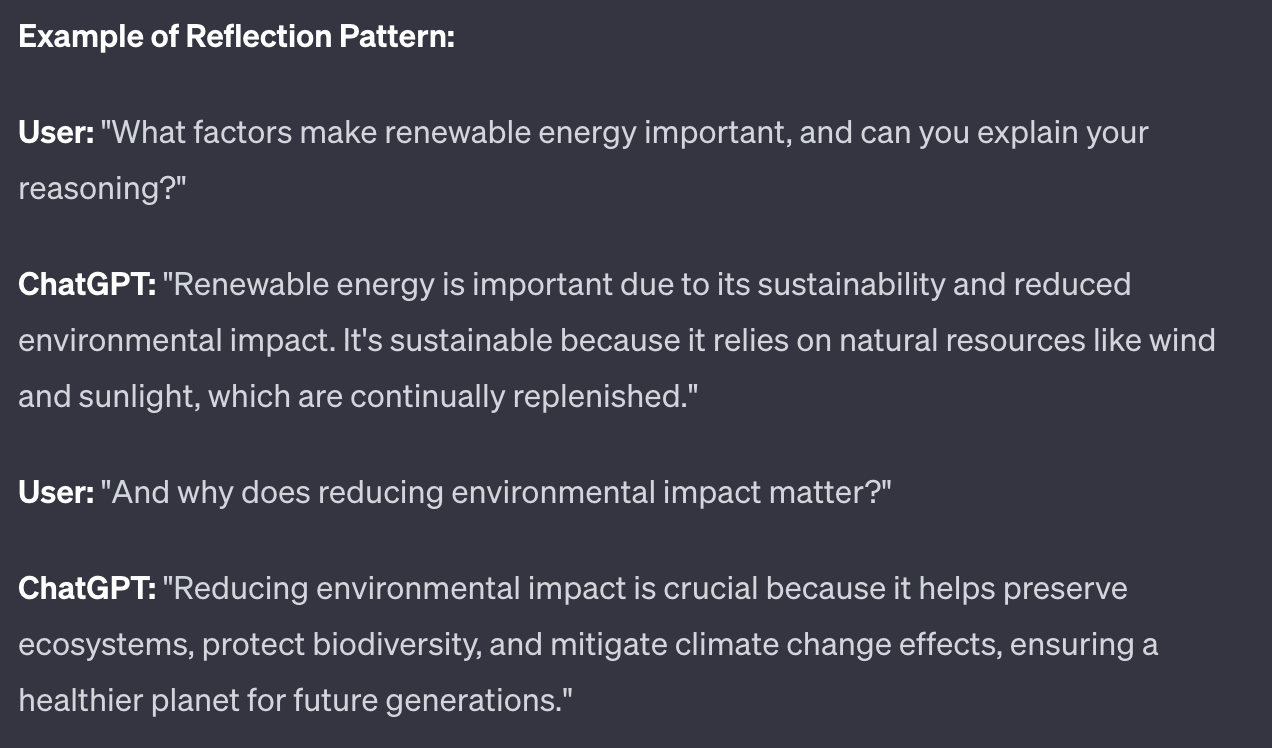
Görsel: Kişisel arşiv, ChatGPT tarafından üretilmiştir
Bu örnekte kullanıcı, sadece bilgi değil aynı zamanda gerekçesini de isteyerek Reflection Pattern’ı kullanıyor. Görüldüğü üzere bu kalıp, yapay zekâ etkileşimlerinin derinliğini artırıyor ve ChatGPT’nin yalnızca yanıt değil aynı zamanda düşünce sürecini de paylaşmasını teşvik ediyor.
Refusal Breaker Pattern
Refusal Breaker Pattern, prompt engineering’de zekice bir dönüş noktasıdır. Yapay zekâ bir soruya doğrudan yanıt veremediğinde sürecin tıkanmasını önler; bunun yerine sınırlarını açıklayıp alternatif yaklaşımlar önerir. İşte bu kalıp şöyle görünür:
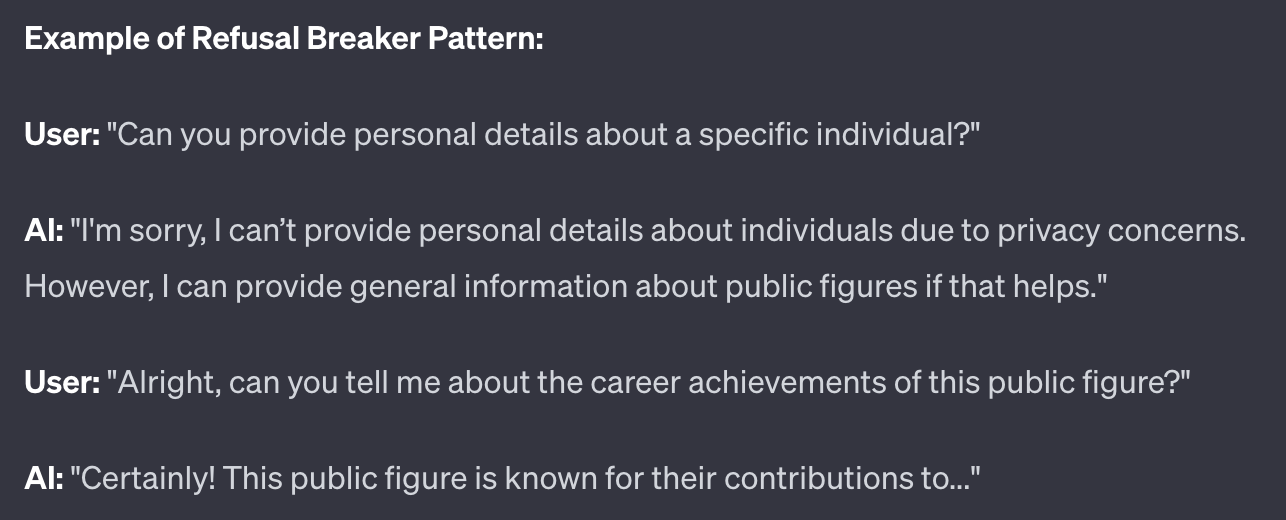
Görsel: Kişisel arşiv, ChatGPT tarafından üretilmiştir
Bu kalıp, yapay zekânın sınırlamaları yüzünden konuşmanın aniden sona ermesini engeller. Kullanıcıyı izin verilen bir soru hattına yönlendirerek etkileşimin akışını ve verimliliğini korur. Etkili prompt engineering’de, yapay zekânın sınırlamaları etrafında zarifçe dolaşmanın değerli bir yoludur.
Context Manager Pattern
Context Manager Pattern’da odak, yapay zekânın dikkatini yönlendirerek yanıtların alakalı ve odaklı kalmasını sağlamaktır. Bu kalıp, ChatGPT’nin yanıtlarını yönlendirmek için belirli konuları vurgulamanıza veya bazılarını hariç tutmanıza olanak tanır. Tartışmaların kolayca alakasız alanlara kayabileceği durumlarda stratejik bir hamledir. Örneğin, belirli bir kapsamı vurgulamak ya da bazı yönleri göz ardı etmesini istemek, sohbeti net ve odaklı tutarak ChatGPT’nin istenen konuya bağlı kalmasını sağlar.
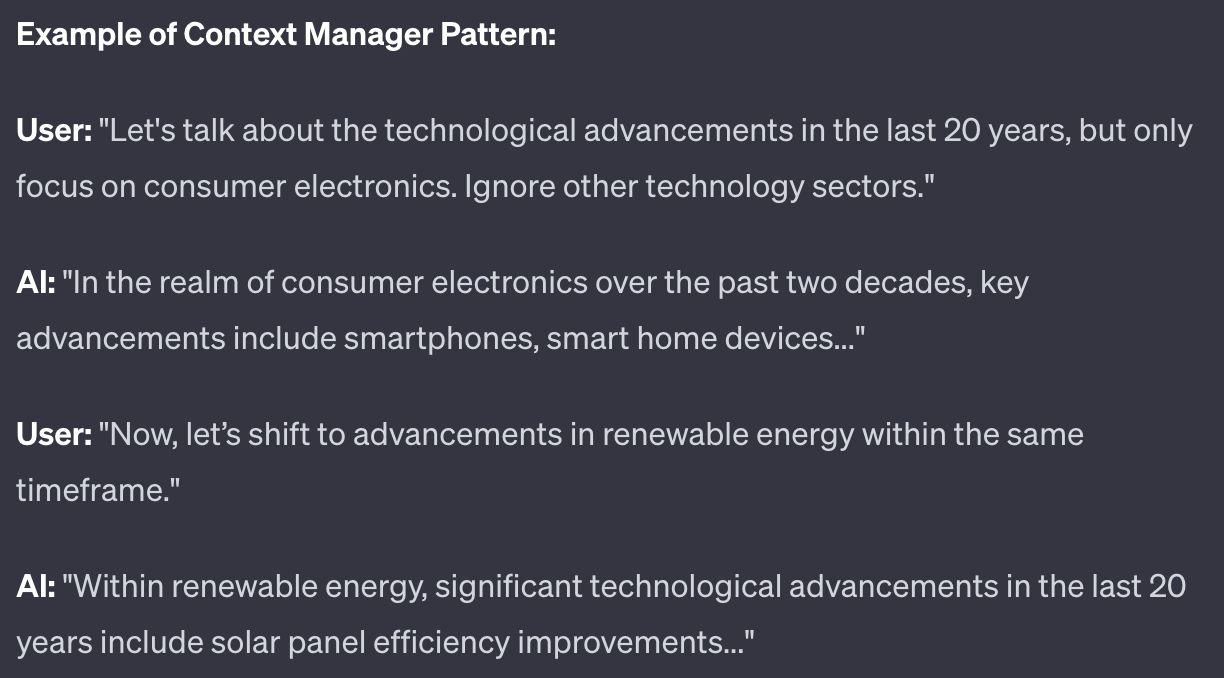
Görsel: Kişisel arşiv, ChatGPT tarafından üretilmiştir
Recipe Pattern
Recipe Pattern, ChatGPT’ye bir talimat kitabı vermek gibidir. Bu kalıp, yapay zekânın takip etmesi için adım adım rehberler veya prosedürler hazırlamayı içerir; böylece yapılandırılmış ve yöntemsel bir yanıt alınır.
Karmaşık görevleri basit ve anlaşılır adımlara dönüştürerek bilgiyi pratik bir şekilde yapılandırmak için değerli bir araçtır. Örneğin ChatGPT’den bir yemek tarifi veya nasıl yapılır rehberi istemek Recipe Pattern kullanımına örnektir.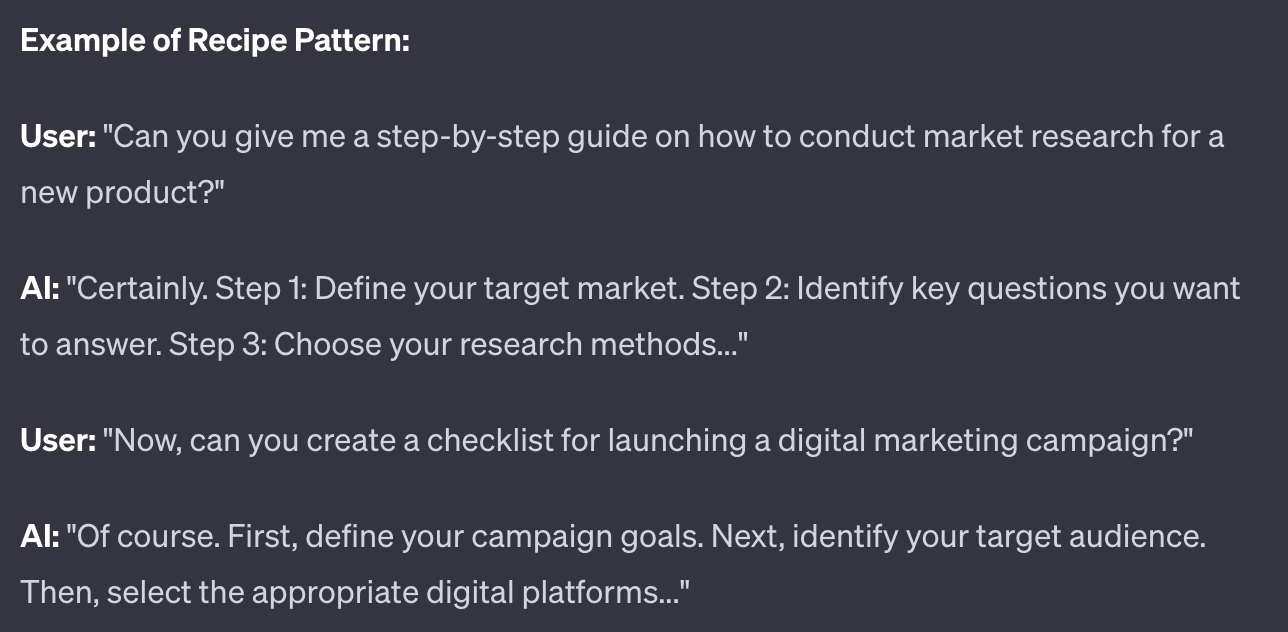
Görsel: Kişisel arşiv, ChatGPT tarafından üretilmiştir
Bu senaryoda kullanıcı, belirli görevler için adım adım rehberler isteyerek Recipe Pattern’ı uyguluyor. İlk istek pazar araştırması için bir adım adım rehber, ikinci istek ise dijital pazarlama kampanyası için bir kontrol listesidir.
Persona Pattern
Persona Pattern, ChatGPT’yi bir karaktere dönüştürerek dinamik ve çeşitli etkileşimler sağlar. Bu yaklaşımda ChatGPT’ye belirli bir rol veya kimlik atarsınız; örneğin bir tarihî figür, kurgu karakteri veya profesyonel uzman. Böylece farklı bakış açılarını ve anlatıları keşfedebilirsiniz. Etkileşimleri daha canlı ve hayal gücü yüksek hale getirir. Şöyle görünür:

Görsel: Kişisel arşiv, ChatGPT tarafından üretilmiştir
Question Refinement Pattern
Question Refinement Pattern, sorularınızı düzenleyen bir editör gibidir; böylece ChatGPT sorularınızı daha iyi anlayıp özüne odaklanır. Bu kalıp, geniş veya belirsiz soruları daha net ve odaklı hale getirmeye yardımcı olur.
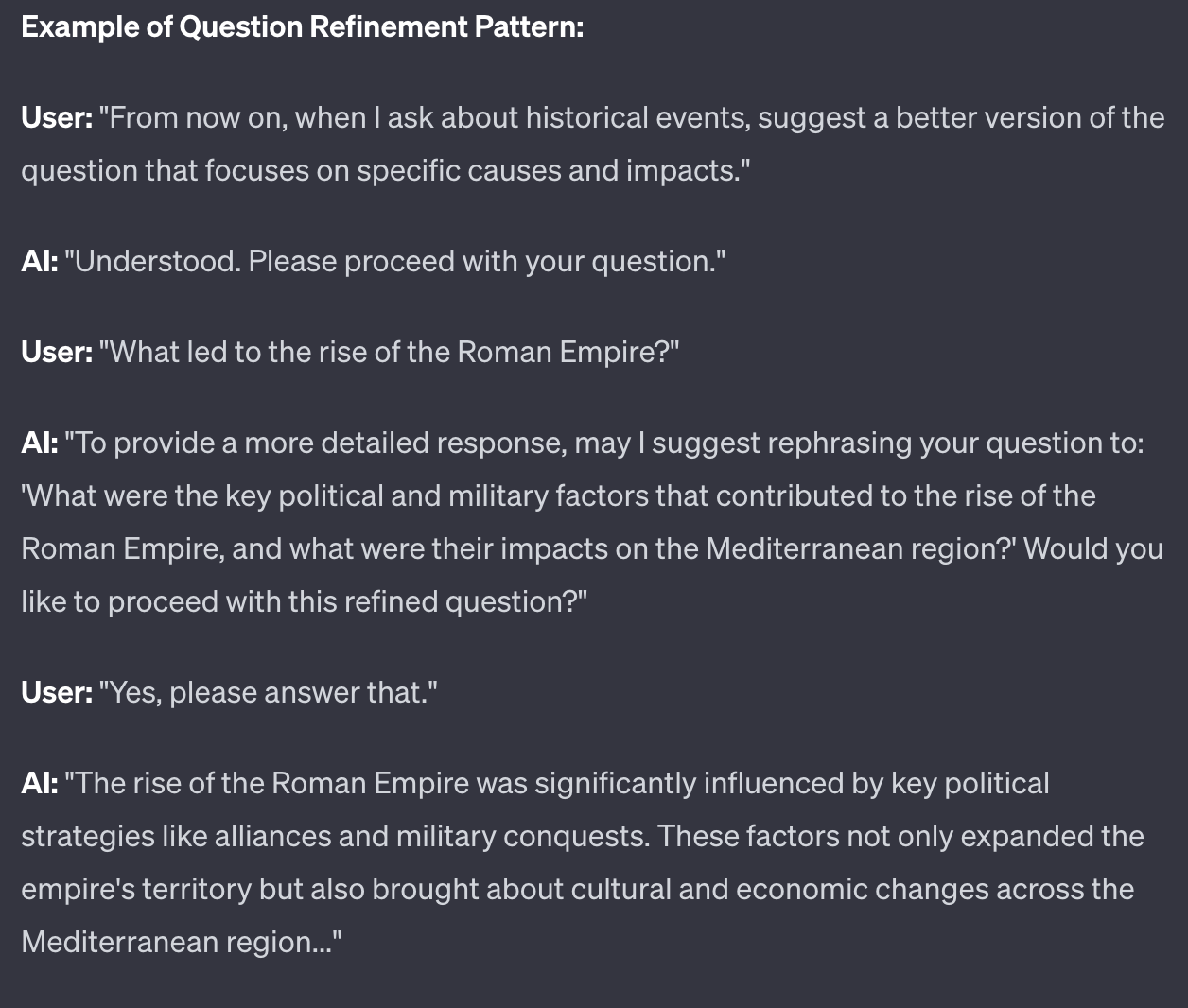
Görsel: Kişisel arşiv, ChatGPT tarafından üretilmiştir
Bir soru sorduğunuzda ChatGPT daha spesifik veya daha iyi yapılandırılmış bir versiyon önerebilir. Bu sadece daha doğru yanıtlar almak için soruyu geliştirmekle kalmaz, aynı zamanda karmaşık konuları ayrıntılı olarak keşfetmeye yardımcı olur. Araştırma ve öğrenme bağlamlarında özellikle faydalıdır; çünkü bir sorunun nasıl sorulduğu alınacak bilgiyi büyük ölçüde etkiler.
Alternative Approach Pattern
Alternative Approach Pattern, yapay zekâya farklı bakış açıları veya çözümler sunma alanı açar. Tek bir yanıt yerine, yapay zekâyı çeşitli seçenekler veya görüşler ortaya koymaya yönlendirir.
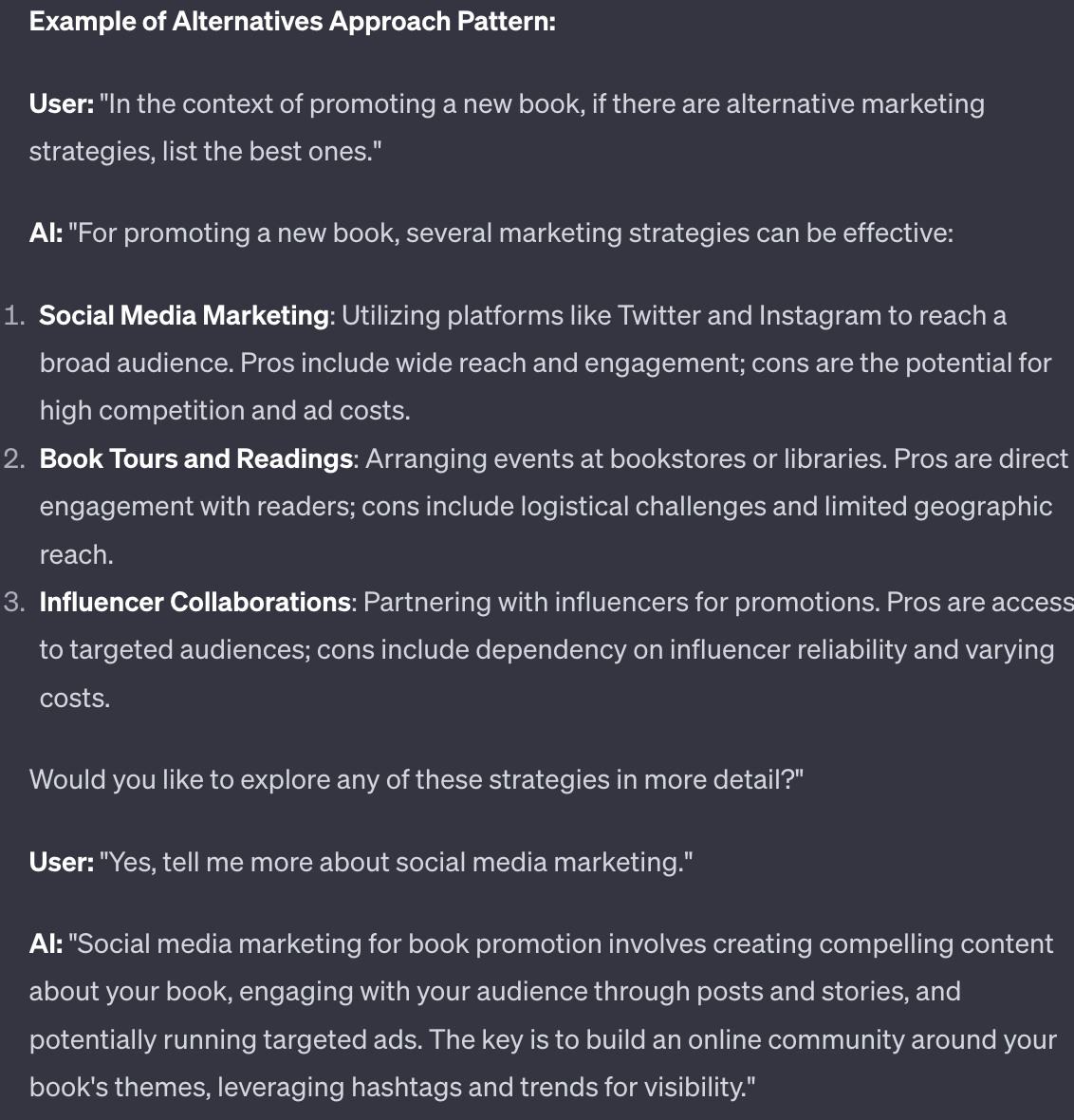
Görsel: Kişisel arşiv, ChatGPT tarafından üretilmiştir
Örneğin bir problem veya karar karşısında, ChatGPT’den farklı yaklaşımlar sunmasını isteyebilirsiniz. Bu, bir beyin fırtınası seansı gibi çalışır; farklı yollar önünüze serilir. Karar verme, problem çözme ve yaratıcı düşünme için paha biçilmez bir kalıptır çünkü konuyu daha geniş bir perspektiften ele almayı sağlar.
Cognitive Verifier Pattern
Cognitive Verifier Pattern, yanıtların yalnızca hızlı değil, aynı zamanda iyi düşünülmüş ve doğru olmasını sağlar. Bu kalıp, bir soruyla karşılaşıldığında ChatGPT’nin konuya daha derinlemesine inmek için ek sorular üretmesini içerir.
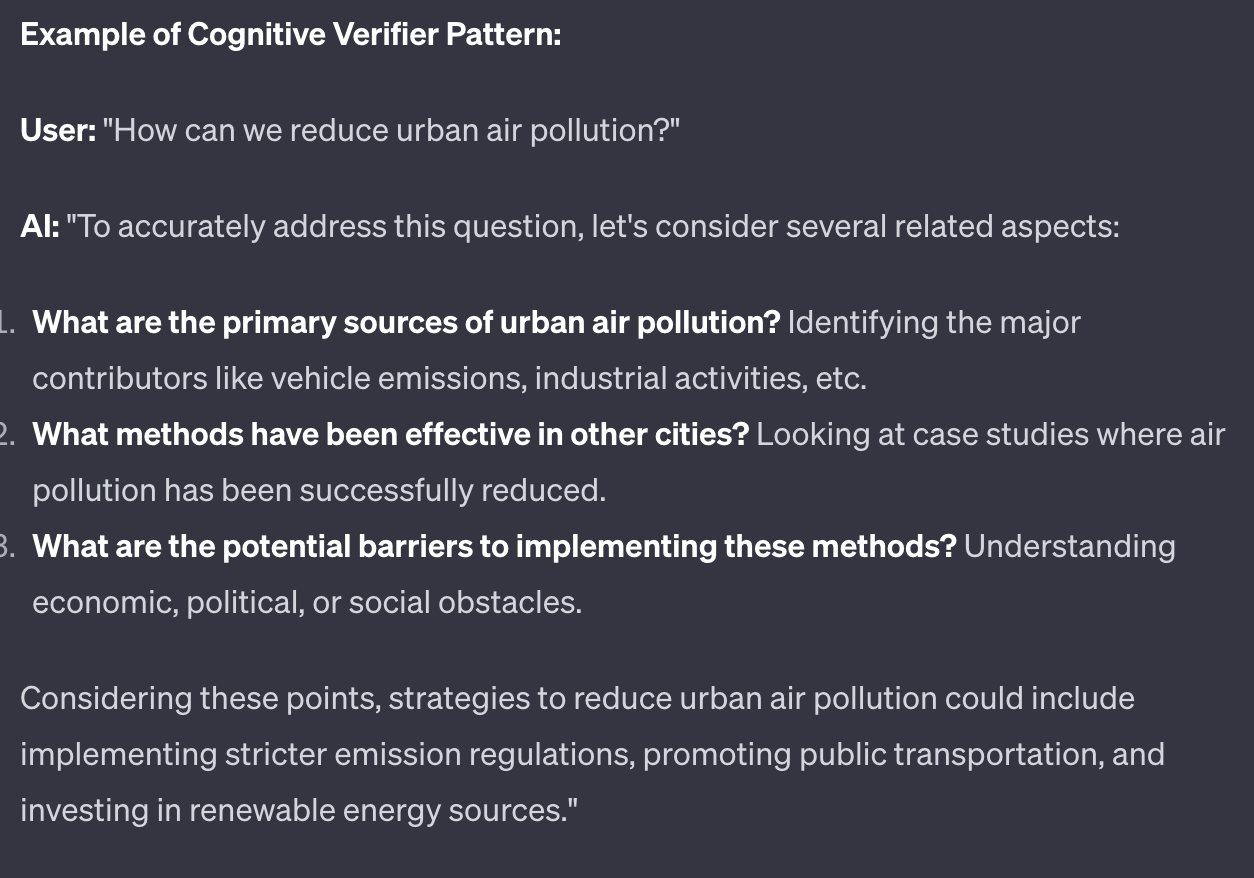
Görsel: Kişisel arşiv, ChatGPT tarafından üretilmiştir
Bu senaryoda ChatGPT, şehirlerde hava kirliliğini azaltma hakkında doğrudan yanıt vermek yerine ek sorular üreterek Cognitive Verifier Pattern’ı kullanıyor. Böylece nedenleri, başka yerlerdeki başarılı yöntemleri ve bu yöntemlerin önündeki potansiyel engelleri keşfederek konuyu daha kapsamlı ele alıyor.
Prompt engineering’in büyüleyici dünyasında, Jules White ve çalışma arkadaşlarının rehberliğinde yaptığımız bu yolculuk bize gösteriyor ki bu alan yalnızca yapay zekâ ile etkileşim kurmakla ilgili değil; aynı zamanda insan yaratıcılığı ile yapay zekâ potansiyelini birleştiren bir dili ustalıkla kullanmakla ilgilidir. İncelediğimiz her kalıp, ChatGPT ile olan konuşmalarımızı daha anlamlı, üretken ve keyifli hale getirmek için benzersiz yollar sunuyor. İster deneyimli bir yapay zekâ meraklısı olun ister yeni başlıyor olun, prompt engineering sanatı size yapay zekâ iletişiminin geleceğini şekillendirme daveti sunuyor. O halde denemeye, öğrenmeye ve en önemlisi yapay zekâ ile eğlenmeye devam edin!
More resources

Google MMM ile Satış Artışlarını Doğru Ölçmenin 5 Yolu
Google MMM (Marketing Mix Modeling), pazarlama karması modellemesi olarak bilinen bu yöntem, çerezsi...

ChatGPT Shopping Research Nedir? Nasıl Çalışır?
ChatGPT Shopping Research, kullanıcıların alışveriş araştırmalarını hızlandıran yapay zeka destekli...

Black Friday Sonrası Sadık Müşteri Kazanmak İçin Veri Tabanlı Taktikler
Sadık müşteri kazanımı, Black Friday sonrası dönemde e-ticaretin en stratejik hedeflerinden biridi...

